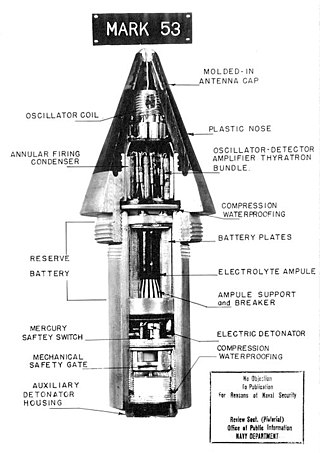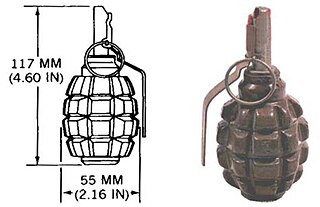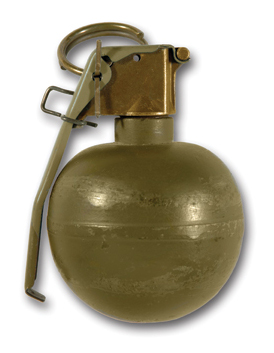Fuse or FUSE may refer to:

Fuze Beverage, commercially referred to as simply Fuze, is a manufacturer of teas and non-carbonated fruit drinks enriched with vitamins. Currently the brand consists of five vitamin-infused lines: Slenderize, Refresh, Tea, Defensify, and Vitalize. The use of vitamins, amino acids, and herbs, and alternative sweeteners such as crystalline fructose places Fuze products in what is known in the industry as the new age beverage category.

A proximity fuze is a fuze that detonates an explosive device automatically when it approaches within a certain distance of its target. Proximity fuzes are designed for elusive military targets such as airplanes and missiles, as well as ships at sea and ground forces. This sophisticated trigger mechanism may increase lethality by 5 to 10 times compared to the common contact fuze or timed fuze.

A shell, in a military context, is a projectile whose payload contains an explosive, incendiary, or other chemical filling. Originally it was called a bombshell, but "shell" has come to be unambiguous in a military context. A shell can hold a tracer.

In an explosive, pyrotechnic device, or military munition, a fuse is the part of the device that initiates function. In common usage, the word fuse is used indiscriminately. However, when being specific, the term fuse describes a simple pyrotechnic initiating device, like the cord on a firecracker whereas the term fuze is used when referring to a more sophisticated ignition device incorporating mechanical and/or electronic components, such as a proximity fuze for an M107 artillery shell, magnetic or acoustic fuze on a sea mine, spring-loaded grenade fuze, pencil detonator, or anti-handling device.

The Soviet F-1 hand grenade is an anti-personnel fragmentation defensive grenade. It is based on the French F1 grenade and contains a 60 g (2.1 oz) explosive charge (TNT). The total weight of the grenade with the fuze is about 600 g (21 oz).

The M67 grenade is a fragmentation hand grenade used by the United States military. The M67 is a further development of the M33 grenade, itself a replacement for the M26-series grenades used during the Korean and Vietnam Wars, and the older Mk 2 "pineapple" grenade used since World War I.

The M26 is a fragmentation hand grenade developed by the United States military. It entered service around 1952 and was used in combat during the Korean War. Its distinct lemon shape led it to being nicknamed the "lemon grenade".
The M7 is a small, metal-cased United States anti-tank blast mine that was used during the Second World War. It was based on the British Hawkins grenade. Approximately 2.5 million were produced before production ceased, and although it has long since been withdrawn from U.S. service, it can be found in Angola, Burma, Cambodia, Chad, Eritrea, Ethiopia, Korea, Lebanon, Myanmar, Somalia, Thailand, and Zambia.
The PDM amphibious mines are series of Soviet anti-vehicle mines that could be used on or in beaches, rivers, lakes and shallow coastal waters up to five meters deep.

The SC 250 was an air-dropped general purpose high-explosive bomb built by Germany during World War II and used extensively during that period. It could be carried by almost all German bomber aircraft, and was used to notable effect by the Junkers Ju 87 Stuka. The bomb's weight was about 250 kg, from which its designation was derived.

Short-Fuze is a fictional character from the G.I. Joe: A Real American Hero toyline, comic books and animated series. He is the G.I. Joe Team's original mortar soldier and debuted in 1982.

Ammunition is the material fired, scattered, dropped, or detonated from any weapon or weapon system. Ammunition is both expendable weapons and the component parts of other weapons that create the effect on a target.
In military munitions, a fuze is the part of the device that initiates its function. In some applications, such as torpedoes, a fuze may be identified by function as the exploder. The relative complexity of even the earliest fuze designs can be seen in cutaway diagrams.

A grenade is an explosive weapon typically thrown by hand, but can also refer to a shell shot from the muzzle of a rifle or a grenade launcher. A modern hand grenade generally consists of an explosive charge ("filler"), a detonator mechanism, an internal striker to trigger the detonator, an arming safety secured by a transport safety. The user removes the transport safety before throwing, and once the grenade leaves the hand the arming safety gets released, allowing the striker to trigger a primer that ignites a fuze, which burns down to the detonator and explodes the main charge.
Füzes or Fuzes may refer to:

An artillery fuze or fuse is the type of munition fuze used with artillery munitions, typically projectiles fired by guns, howitzers and mortars. A fuze is a device that initiates an explosive function in a munition, most commonly causing it to detonate or release its contents, when its activation conditions are met. This action typically occurs a preset time after firing, or on physical contact with or detected proximity to the ground, a structure or other target. Fuze, a variant of fuse, is the official NATO spelling.
A magnetic proximity fuse was patented by P.J. Eliomarkakis, although similar devices had been in service for nearly a decade. It is a type of proximity fuze that initiates a detonator in a piece of ordnance such as a land mine, naval mine, depth charge, or shell when the fuse's magnetic equilibrium is upset by a magnetic object such as a tank or a submarine.
Short fuse and similar may refer to:











